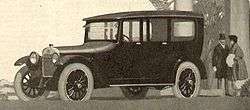Oakland Motor Car Company
|
| |
| Automobile manufacturing | |
| Industry | Automotive |
| Genre |
Touring cars Automobile engines |
| Founded | 1907 |
| Founder | Alanson Brush |
| Defunct | 1931 (renamed Pontiac) |
| Headquarters | Pontiac, Michigan, United States |
Area served | United States |
Key people |
Edward Murphy, President Alanson Brush, Chief Engineer |
| Products |
Vehicles Automotive parts |
| Owner | General Motors 1909-1931 |
The Oakland Motor Car Company of Pontiac, Michigan, was an American automobile manufacturer and division of the General Motors Corporation. Purchased by General Motors in 1909, the company continued to produce modestly priced automobiles until 1931 when it was renamed Pontiac.
Beginning

The company was named for Oakland County, Michigan, in which it was based. As originally conceived and introduced, the first Oakland used a vertical two-cylinder engine that rotated counterclockwise.[1] This design by Alanson Partridge Brush, inventor of the single-cylinder Cadillac and Brush Runabout, also featured a planetary transmission.[1] Five models were created, designated Model A–E with each subsequent letter increasing in total vehicle size.[2] 1908, the first year of Oakland production, saw 278 vehicles roll off the line.[2]
GM Takeover

After one year of production, Oakland's principal founder, Edward Murphy, sold half of the company to William C. Durant's General Motors Corporation in early 1909.[2] When Murphy died in the summer of 1909, GM acquired the remaining rights to Oakland. Within General Motors, Oakland was slotted above price leader Chevrolet and below the more premium Oldsmobile, Buick and Cadillac brand cars. Conventional 4-cylinder engined models were introduced shortly after the GM takeover.[1]
In 1916, the company introduced a V8 engine,[3] and production soared to 35,000 in 1917, shared with the Chevrolet Series D.[1] By early 1920, however, production and quality control problems began to plague the division. In 1921, under new General Manager Fred Hannum, a consistent production schedule was underway and the quality of the cars improved, and Oakland vehicles shared the GM A platform used by Chevrolet. One marketing tactic was the employment of a quick-drying bright blue automotive lacquer by Duco (a DuPont brand product), leading to the slogan "True Blue Oakland."
The Oakland vehicle was built only in Pontiac, Michigan, which is the county seat of Oakland County. The name predates any GM association with an automobile manufacturing facility in Oakland, California, that built Chevrolet vehicles before Chevrolet joined GM called Oakland Assembly.
Pontiac


As General Motors entered the 1920s, the product ladder started with the price-leading Chevrolet marque, and then progressed upward in price, power and luxury to Oakland, Oldsmobile, Buick and ultimately Cadillac. By the mid-1920s, a sizable price gap existed between Chevrolet and Oakland, as well as a wide gap between Oldsmobile and Buick. There was also a product gap between Buick and Cadillac. General Motors pioneered the idea that consumers would aspire to buy up an automotive product ladder if a company met certain price points-called the Companion Make Program. To address this, General Motors authorized the introduction of four brands priced and designed to fill the gaps. Cadillac would introduce the LaSalle to fill the gap between Cadillac and Buick. Buick would introduce the Marquette to handle the upper end of the gap between Buick and Oldsmobile. Oldsmobile would introduce the Viking, which took care of the lower end of the same gap.
Oakland's part in this plan was the 1926 Pontiac, a shorter wheelbase "light six" priced to sell at a 4 cylinder car's price point, but still above Chevrolet. Pontiac was the first of the companion marques introduced, and in its first year sold 49,875 units.[2] By 1929, GM sold 163,000 more Pontiacs than Oaklands. The discontinuation of Oakland was announced with the onset of the Great Depression 1931. Pontiac was the only companion make to survive beyond 1940, or to survive its "parent" make.
References
- 1 2 3 4 Georgano, G. N., ed. (1971). Encyclopedia of American Automobiles (2nd ed.). London: Rainbird Reference Books. p. 144. ISBN 0-525-097929.
- 1 2 3 4 "Oakland History". Oakland-Pontiac Worldwide. Retrieved 19 December 2014.
- ↑ Clymer, Floyd. Treasury of Early American Automobiles, 1877-1925 (New York: Bonanza Books, 1950), p.166.
- Kimes, Beverly R., Editor.; Clark, Henry A. (1996) [1985]. The Standard Catalog of American Cars 1805-1945. Iola, Wisconsin: Kraus Publications. ISBN 0-87341-428-4. OCLC 34905743.
External links
| Wikimedia Commons has media related to Oakland vehicles. |
Coordinates: 42°39′45″N 83°17′22″W / 42.6625501°N 83.2893976°W